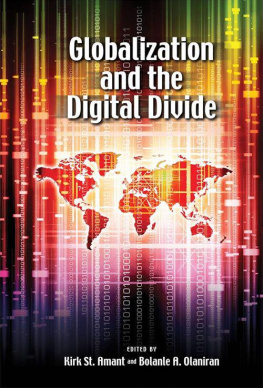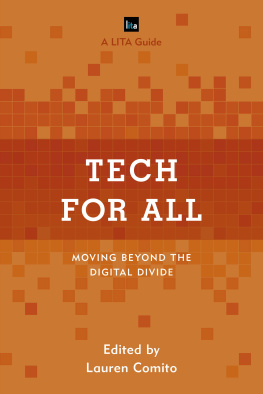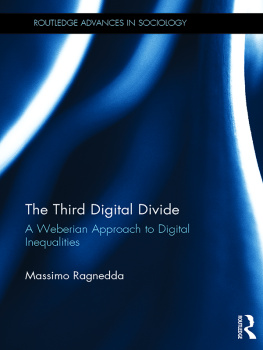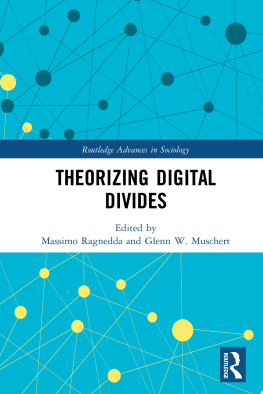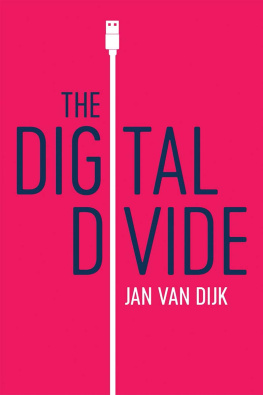Globalization
and the
Digital Divide
Bolanle A. Olaniran
Kirk St.Amant

Amherst, New York
Copyright 2011 Kirk St.Amant and Bolanle A. Olaniran
All rights reserved.
Printed in the United States of America
No part of this publication may be reproduced, stored in or introduced into a retrieval system, or transmitted, in any form, or by any means (electronic, mechanical, photocopying, recording, or otherwise), without the prior permission of the publisher.
Requests for permission should be directed to:
permissions@cambriapress.com, or mailed to:
Cambria Press
20 Northpointe Parkway, Suite 188
Amherst, NY 14228
Library of Congress Cataloging-in-Publication Data
Globalization and the digital divide/edited by Kirk St. Amant and Bolanle Olaniran.
p. cm.
Includes bibliographical references and index.
ISBN 978-1-60497-770-7
1. Digital divideDeveloping countries. 2. Information technology Developing countries. 3. Economic developmentDeveloping countries. 4. GlobalizationSocial aspects. I. St. Amant, Kirk, 1970-II. Olaniran, Bolanle, 1964- III. Title.
HN981.I56G56 2011
303.48'33091724dc232011038447
For my daughters, Lily and Isabelle, who are a source of inspiration in all that I do; for my wife, Dori, whose continued patience and support were essential to this project; to Dr. Mark D. Hawthorne, and to the memory of Dr. Victoria Mikelonisthe individuals who introduced me to the concept of computing in global contexts.
Kirk St.Amant
First, I would like to give all honor and glory to the Lord. And I am deeply grateful to my wife, Adeline, who allows me to spend the necessary time on my research; her undying love is essential in all that I do and accomplish. My mother, Alice, and my brothers, Dan and Sunday, I thank for their prayers, love, and support. My thanks go also to Gus Friedrich, my mentor and adviser, for believing in me. I am grateful to all who have found my work useful in the areas of globalization, technology, and culture; I am humbled. Finally, I dedicate this work to the memory of my father, who helped instill in me the need to keep reaching for the stars.
Bolanle A. Olaniran
Introduction
Globalization and the Digital Divide
Understanding the Connections between Technology and Communication in a Global Context
Kirk St.Amant
Globalization as Communication
In essence, globalization is about integration at an international level. In many cases, this integration is economic and is driven by business practices and trade agreements. In other cases, it is ideological, occurring as different ideas and perspectives move back and forth across nations and regions. In every instance, however, globalization involves one central factorcommunication. Effective communication provides individuals with the information they need to participate in todays global society as consumers, workers, and citizens. It is only through the effective sharing of information on a global level that everything from policies on international trade to the diffusion of MP3 files can take on a truly international nature.
Within this communication framework, the concept of access is central. That is, only people with access to essential information can participate effectively in todays global marketplace for goods, services, and ideas. Access, in turn, is often dependent on media or on the technologies used to present and exchange ideas. In the case of globalization, the media requisite for access are usually electronic or online in nature. What makes such media critical is the speed and directness with which they allow individuals to locate and exchange information on a global scale. E-mail, for example, allows a person in Boston to exchange information with someone in Beijing almost as quickly and directly as that person could convey the same information to a neighbor across the street.
Globalization and Online Access
As of this writing, almost 2 billion people around the world can connect to the online environment (Adair, 2010; Internet Usage Statistics: The Internet Big Picture, 2010). Although this number represents roughly one third of the worlds population, international online access continues to increase with amazing speed. The number of Internet users in Australia, for example, grew by almost 400,000 between June and August 2004 (Active Internet Users, 2004), and today Australians spend more time interacting via Web 2.0 media than any other culture (Marshall, 2010). In Japan almost 80% of the population has online access (Internet Usage in Asia, 2010), and in South Korea 39 million of the nations 48 million citizens can connect to the Internet. In addition, broadband access in South Korea has continued to grow rapidlyby almost 1 million individuals between 2008 and 2009 alone (Internet Usage in Asia, 2010; Whitney, 2009). This degree of online access has placed the connected, or the wired, nations of the world at the forefront of globalization as it relates to both international trade and the sharing of ideas, entertainment, and policies on a global scale.
The most astounding growth in online access is taking place in developing nations. The number of Internet connections in India, for example, was expected to grow by over 40% in 2009, and this number includes some 51 million active Internet usersalmost double the number of Internet users in the ultrawired Scandinavian countries (Internet Usage in Europe, 2010; Lau, 2010). Online access in China grew exponentiallyby almost 2000%during the last decade: Individuals with online access increased from 22.5 million to almost 420 million individuals in that time (Internet Usage in Asia, 2010). Furthermore, Chinas mobile-phone marketsanother source of potential online accessare expected to include some 1.3 billion subscribers by the middle of the next decade (Lau, 2010). Similarly, the number of individuals going online in Eastern Europe has grown markedly since the turn of the millennium. For example, Lithuania, Latvia, Poland, and Russia have all experienced increases in online access of over 500% during in the last decade (Internet Usage in Europe, 2010), and broadband use is rapidly increasing; Ukraine, for one, experienced more than 15% growth in broadband access in 2009 (Whitney, 2009).
Though this growth in online access seems remarkable, the ratio of such growth in comparison to the population of developing world paints a very different picture. In truth, the worlds emerging economies appear to be at a distinct disadvantage when it comes to participating in the global information economy. For example, whereas Asia is home to just over half of the worlds population, as of this writing only 22% of those living there have Internet access (Adair, 2010; Internet Usage Statistics: The Internet Big Picture, 2010). Likewise, only about 10% of the population of Africaa continent with a population of just over 1 billionhas online access (Adair, 2010; Internet Usage Statistics for Africa, 2010). A similar situation obtains in many other less economically developed regions of the world, including South and Central America and parts of the former Communist Bloc.
Yet this situation is far from hopeless. Over the last decade, various projects have been undertaken with the goal of increasing online access in the worlds developing nations. In Africa, a mix of public- and private-sector ventures focuses on increasing online access across the continent (High Speed Internet Access, 2010; Kalia, 2001; Lister, Dovey, Giddings, Grant, & Kelly, 2003). In Latin America, similar public and private ventures have been proposed, and although less than half of South Americas population is currently online, impressive gains have been made in the nations of Brazil, Argentina, and Chile (Ballve, 2008; Internet Usage And Populations in South America, 2010; Tying Latin America Together, 2001). These developments, combined with some of the worlds lowest Wi-Fi costs and Latin Americas fast-growing markets for mobile phones, might assist with the spread of online access there (Ballve, 2008; Burger, 2004; 11 Trends, 2004).

